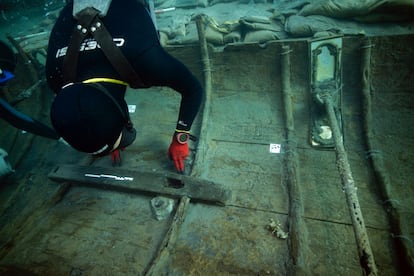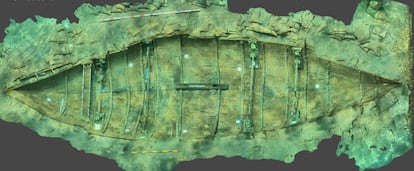In the 7th century BC, a Phoenician boat measuring just over 8 metres in length was wrecked on the coast of the Region of Murcia, about 50 metres from what is now La Isla beach, in the town of Puerto de Mazarrón (about 10,500 inhabitants). The boat was discovered at a depth of about 2.5 metres in 1994 and, after almost three decades of debate on whether or not it should be extracted from the sea, that moment has arrived: it will be removed from its original site to be treated in the specialised laboratories of the National Museum of Underwater Archaeology (ARQUA), in Cartagena, next September. Experts in underwater archaeology and naval architecture are already finalising preparations to carry out this delicate operation, which will last approximately two months, until the end of October.
The extraction of the wreck will have nothing to do with “the bucolic idea” of a ship emerging from the water in its entirety, “as if we were in the film ‘Pirates of the Caribbean’,” warns archaeologist Carlos de Juan, an expert from the University of Valencia who will be leading the work and who also led the detailed study that was carried out last summer on the remains to document them and check their real state. Such an action, he insists, would be completely unfeasible, due to the age of the wood, the weak state in which it is found and, above all, because the ship “is already fractured, with thousands of visible and invisible fissures, and with multiple separations.” “The small wreck is totally fragmented, it is a set of many planks supported by sand. When we remove that sand to remove it, the ship will break apart,” he summarises.
De Juan wants to clear up all the doubts that have arisen in recent years, since the decision was made to extract the wreck in 2021, regarding the way in which it will be carried out. Some voices had insisted on the possibility of removing the entire ship and gave as an example cases of other ships such as the “Mary Rose”, found in England, or the “Delta II”, in Cádiz. The archaeologist recalls that both are large warships (the Phoenician wreck measures only 8.20 metres in length; 2.20 metres in width and a maximum depth of 0.90 metres), and were built in the 16th century, some 2,000 years after the “Mazarrón II”. Nor does the wood of these ships have “anything to do” with that of the Phoenician wreck, made of fig wood for the frames and pine for the planks of its base, only about 3 centimetres thick, and which has hardly any “structure in itself”.
With the scientific data in hand, the researchers have drawn up a proposal to extract the wreck divided into 20 sections, which will be placed on a kind of resin “trays” that are currently being manufactured specifically for this project. These are structures in which the shape of each of the sections has been cast using a 3D construction system, which will rest horizontally on these boxes to be transferred to ARQUATec, the specialized laboratory of the National Museum of Cartagena, one of the most advanced in Europe and also worldwide.
The extraction will last about two months, at a rate of two days of work for each of the sections, tasks that will be carried out by a multidisciplinary team of 14 people (ten at the bottom of the sea and another four in the “field laboratory” that will be installed in the area in August).
The pieces of the wreck will be transported to the Cartagena laboratory, where they will first undergo mechanical cleaning to remove any possible traces of sand, plants or marine animals, followed by osmosis to remove any salt crystals and a preventative treatment against possible contamination by iron oxides. They will then spend two to three years submerged in a type of resin called polyethylene glycol (PEG), which allows the cellular cavities of the wood to be filled, replacing the water they contained. Once this long process is complete, the wood will be frozen below 90 degrees, before undergoing “lyophilization,” a process in which the planks are subjected to a vacuum to achieve the sublimation of water, that is, to change it from a solid to a gaseous state without passing through the liquid state, thus allowing the wood to dry without deformation.
All ARQUATec technicians will be involved in the process, as well as specialists from the United States and Turkey. The entire procedure is estimated to take four years, which is how long it will take before it can be exhibited to the public, and where it will be done is another of the issues that have generated controversy around the Phoenician ship.

The director general of Heritage of the autonomous community, José Francisco Lajara, is cautious in this regard and insists that the time that the conservation process will take must be used to generate a space that meets all the necessary conditions for the exhibition. Until now, he highlights, the collaboration between the autonomous community and the Ministry of Culture has been fruitful in every sense: both administrations agreed in 2021 that the best thing for the ship was to remove it from the sea, once it was verified that the metal box with which it had been protected, installed in 2000, was sinking into the sand at a faster rate than the wreck, which generated the risk of crushing it, a decision that was endorsed in May 2022 by UNESCO. The autonomous community will invest 350,000 euros in the work of extracting the ship, and it will be the Ministry that finances the subsequent treatment in the ARQUA laboratories.
The extraction, says the politician, generates “excitement” and a “tremendous responsibility”, because it will be “a milestone for heritage, at a regional level, but also nationally and internationally”. Only a handful of vessels from this period or older are preserved in the world, and this specimen is what in archaeology is considered a “unicum”, a unique object, which will open the door to studying not only aspects of shipbuilding and navigation in Phoenician times, but also the interaction of that culture with the local inhabitants of the area, the “hybrid” techniques and customs of this part of the Mediterranean in that very remote time, says De Juan. Along with the wreck, which is practically complete, all of its cargo was found, which was extracted between 1999 and 2001: more than two tons of lead ore ingots, an amphora, a hand mill, a basket made of esparto grass with a wooden handle, remains of esparto ropes of various thicknesses and types, packing materials for stowage and protection of the hull, and its anchor, made of wood and lead. For the general director, “learning everything possible about the wreck” is, in fact, the main objective of this extraction, because he believes that the subsequent study of the vessel will provide a great deal of historical information about how the Region of Murcia was “a strategic point in international trade more than 2,500 years ago.”

